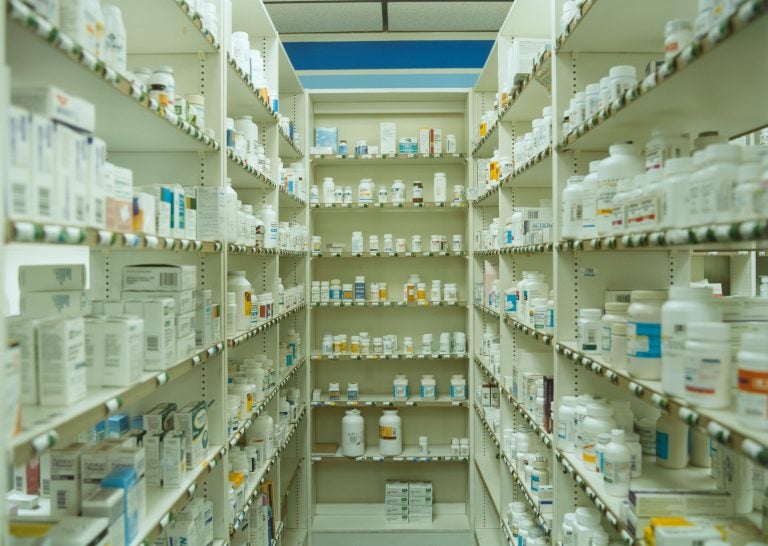Report: Here’s what the Feds can do to cut drug prices

What makes drug prices so high? Let us count the ways. (Brad Wilson/Getty Images)
Drug prices are too high and we’d better do something about it. That’s the nutshell conclusion of a 201-page report from the National Academies of Sciences, Engineering and Medicine.
“High and increasing costs of prescription drugs coupled with the broader trends in overall medical expenditures, which now equals 18 percent of the nation’s gross domestic product, are unsustainable to society as a whole,” says Norman Augustine, the former CEO of defense contractor Lockheed Martin and the chair of the committee that conducted the study released Thursday.
The sentiments were echoed Wednesday by President Trump’s nominee to lead the Department of Health and Human Services.
“Drug prices are too high,” said Alex Azar in a hearing before the Senate Health Education and Labor Committee.
But the National Academies didn’t stop there. The independent advisory group’s report lists dozens of suggestions of what U.S. officials could do to rein in those rising prices. Many have been tossed around Washington for years. And given the power of the pharmaceutical lobby — it has spent more than $200 million on lobbying so far this year, according to the Center for Responsive Politics — few of them are likely to be implemented soon.
Here’s a rundown of key recommendations:
Allow the federal government to negotiate drug prices and refuse to cover some expensive medications.
This idea is not new, and President Trump himself has advocated for allowing the government, through Medicare, to negotiate lower prices for the drugs it buys. But doing so would take an act of Congress.
Current U.S. law prohibits Medicare officials from interfering in the negotiations between drug makers and the insurance companies that administer Medicare’s prescription drug program.
Medicare accounts for about 29 percent of all prescription spending, so bringing that purchasing power under one roof could give it the ability to force drug makers to slash their list prices.
The National Academies report points out that the government negotiates or sets prices in almost every other industry where it is a buyer, including defense equipment, uniforms and even stationery.
“The effect of not allowing HHS to negotiate prices is to tilt the balance of bargaining power further in favor of drug manufacturers,” the report says.
It adds that Medicare and other government health plans also should have the authority to refuse to pay for medications that have cheaper equivalents or that aren’t adequately effective.
Speed the approval of generics and biosimilars and ensure patients have access.
Scott Gottlieb, the administrator of the Food and Drug Administration, has been preaching this message since he took office in May.
“While FDA doesn’t have a direct role in drug pricing, we can take steps to help address this problem by facilitating increased competition in the market for prescription drugs through the approval of lower-cost generic medicines,” he said in a June blog post.
The National Academies point to so-called “pay for delay,” where a branded drugmaker pays a generic company to delay putting its competitor drug on the market.
The practice “tends to inflate prices and reduce the quantity of prescriptions for several years after the settlement,” the report says.
But eliminating pay-for-delay won’t be easy, because courts have ruled that the agreements between the companies have to be evaluated individually.
Shed light on who pays what for prescription drugs.
This is something that lawmakers and regulators have called for many times. The prescription drug payments system is a tangled web of prices, incentives, discounts and rebates between drug companies, pharmacy benefit managers and insurance companies.
When pharmaceutical companies are criticized for raising their list prices, they routinely protest that nobody actually pays those prices. Yet the true money flows remain a mystery.
There are bills in both houses of Congress designed to increase drug price transparency, and several states — most recently California — have proposed or passed laws to require more information on what drug makers and pharmacy benefit managers actually charge for medications.
The National Academies panel recommends that HHS require pharmaceutical manufacturers to report each year the list price of medications, along with all the rebates and discounts in the system, and finally the average price paid for those drugs.
Discourage those endless ads pushing prescription drugs and stop giving patients coupons to try medication.
Pharmaceutical companies spend far more advertising their medication than they do on research into new products, the report notes. That marketing boosts drug costs both by directly increasing costs to drug makers that they then incorporate into the price of drug, and also by boosting consumer demand for medication they may not need.
“Direct-to-consumer advertising of prescription drugs can adversely influence consumer choices,” the report says.
The reports says lawmakers should prohibit drug companies from deducting the cost of advertising from their taxes and should also ban coupons that allow people to purchase expensive brand-name drugs for the same out-of-pocket cost as generics.
Cut the cost to consumers for their prescription drugs.
This recommendation seems at odds with the earlier one calling for the elimination of coupons. But the National Academies report concludes that keeping costs low to consumers can ensure that patients take the medications they need, which could reduce overall health care spending.
Insurance companies often require patients to pay bigger copayments for expensive medications as a way to encourage them to use cheaper options.
“High cost sharing can also have downsides, since it can lead to reduced adherence or the discontinuation of medications because of high out-of-pocket costs to consumers,” the report says.
The report recommends that Congress limit how much people should have to spend on prescriptions in government-run health programs like Medicare and Medicaid.
Take away incentives for doctors to administer high cost drugs.
This recommendation goes to a failed effort by the Department of Health and Human Services to encourage doctors that treat cancer and arthritis to use lower-cost medications if they’re appropriate. Medicare pays doctors who administer drugs in their offices, including chemotherapy or arthritis drugs that are delivered intravenously, a percentage of the drug’s price.
That gives physicians a financial incentive to choose the most expensive medication available.
Last year, HHS proposed changes to that system, but doctors launched an intense lobbying effort against it.
Bruce Gould, the president of the Community Oncology Alliance, called it an “inappropriate, potentially dangerous and perverse experiment on the cancer care of seniors who are covered by Medicare.”
The program was killed.
Given the outcry, the chances that HHS will try again are slim.
But There Was Dissent, Too.
The report also includes a dissenting opinion from two of the 16 members of the committee. The dissent defends the need for profits in the pharmaceutical industry to give companies the incentive to chase treatments and cures for difficult diseases like Alzheimer’s.
“Creating a drug is a problem completely subject to human biology with all its
intrinsic complexity, variability, and unpredictability,” the dissenting report reads. “If drug invention were simply an engineering problem, then by now we would have a vaccine for AIDS (35 years after the beginning of the outbreak) and a cure for Alzheimer’s disease.”
But even in the dissent there was some agreements, specifically in the need for greater transparency in how drugs are priced, and how the money flows through the system. The dissenters suggest that pharmacy benefit managers have outsized power and take too much money from the system.
President Trump has said he wants to make lowering drug prices a priority. This report offers up plenty of suggestions on how to do that.
9(MDAzMzI1ODY3MDEyMzkzOTE3NjIxNDg3MQ001))




